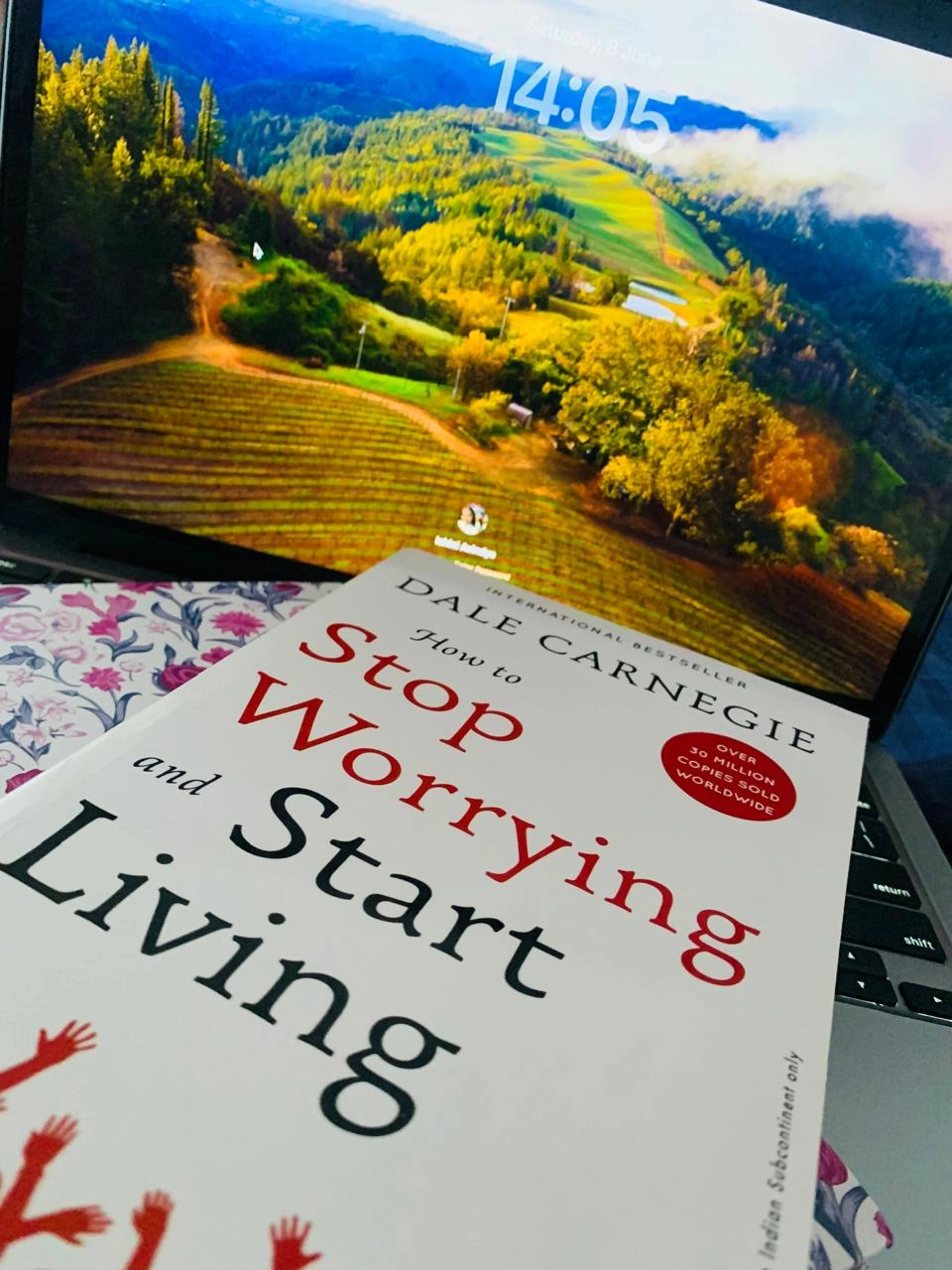Worrying used to consume me, affecting my mental and physical well-being. I have been sick so many times because I worry too much. People could easily hurt me. I used to be silent in the majority of the situations/incidents that I was in just because I was afraid of losing people in my life. That was eating me inside out. Not expressing how you feel makes you die day by day though your heart is still working.
I went through psychiatric sessions, and I had to swallow pills every day just to make my mind calm. I thought, “Why, why me?” I knew I had to find a way to manage and reduce my worries to lead a more fulfilling and stress-free life. It took me ages to even take the first step to make it stop. Remember, we cannot put an end to the subject of “Worrying” but we can manage it effectively so it doesn’t hinder our happiness and well-being.
I already had an interest in human psychology and psychiatry. That made me read so many books written in that area. I came across Dale Carnagie's books: why not try reading his books?
Inspired by Dale Carnegie's timeless wisdom in "How to Stop Worrying and Start Living," I embarked on a journey to stop worrying and start living fully. Here’s how I did it, step by step.
Understanding the Nature of My Worry
I realized that my worry stemmed from a fear of the unknown and a desire to control the future. Accepting that uncertainty is a part of life was the first step. I had to come to terms with the fact that I couldn't control everything and that worrying about potential outcomes didn't change them. This understanding helped me see worry as a habitual thought process that I could alter with conscious effort.
Identifying My Worries
I started by identifying my specific concerns. I made a comprehensive list of the things that caused me to worry. Writing them down helped me see them more objectively and prioritize them based on their significance and likelihood. Once I had my list, I categorized each worry into things I could control and things I couldn't. This categorization helped me focus my energy on the areas where I could make a difference and let go of the rest.
Challenging My Thoughts
I noticed that my worries were often based on irrational fears and worst-case scenarios. Whenever a worry popped up, I asked myself:
Is this a realistic concern?
What evidence supports this worry?
What is the worst that could happen?
How likely is this outcome?
What steps can I take to prevent or handle this?
Challenging my thoughts helped me break the cycle of irrational worry. For instance, if I was worried about a work presentation, I'd ask myself if there was any solid reason to believe it would go poorly. Often, I'd find that my fears were exaggerated and not grounded in reality.
Practicing Mindfulness and Meditation
Mindfulness and meditation became powerful tools for keeping my mind anchored in the present. By focusing on the here and now, I reduced the time spent worrying about the future. Mindfulness involves paying attention to my thoughts, feelings, and sensations without judgment. It helped me become aware of my worry patterns and gently shift my focus back to the present moment.
I spent a few minutes each day practicing mindfulness or meditation to cultivate a peaceful and focused mind. Simple techniques like deep breathing, progressive muscle relaxation, and guided imagery helped reduce stress and promote relaxation.
You can do this even when you are sleeping: or when you are awake, sitting on a chair. Anything that gives your mind peacefulness works.
Developing a Worry Time
I designated a specific time each day for worrying, like 15 minutes in the afternoon. During this time, I allowed myself to think about my worries and consider solutions. Once the time was up, I moved on and avoided dwelling on the outside of this period. This practice helped contain my worries to a manageable portion of my day and prevented them from taking over my thoughts.
Taking Action
Taking proactive steps to address my worries significantly reduced my anxiety. I created a plan of action for the worries I could control. Breaking down the tasks into small, manageable steps and tackling them one at a time empowered me and reduced the sense of helplessness that often accompanies worry.
For example, when I worried about finances, I created a budget and started tracking my expenses. Taking concrete steps helped me regain a sense of control and reduced my anxiety.
Most importantly when I feel no action can address the cause of my worry, I start leaving all of them behind and move forward like nothing happened. I find this too difficult but at least I am making an effort and I am practicing it as much as I can. Trust me a little step taken towards that goal has healed me day by day.
Staying Active and Engaged
Physical activity became a great way to reduce stress and clear my mind. I engage in regular exercise, whether it is a walk, a gym session, or a yoga class. Exercise released endorphins, which were natural mood lifters. Additionally, I stayed engaged in activities I enjoyed and spent time with people who made me feel happy and supported. Social interactions and hobbies distracted me from my worries and provided a sense of fulfillment and joy.
Maintaining a Healthy Lifestyle
I realized that a healthy body supports a healthy mind. I made sure to get enough sleep, eat a balanced diet, and avoid excessive caffeine and alcohol, which can increase anxiety. A healthy lifestyle made me more resilient to stress and worry. I also incorporated relaxation techniques such as deep breathing, progressive muscle relaxation, and guided imagery to help me unwind and manage stress.
Seeking Support
Talking about my worries with trusted friends, family members, or a therapist provided relief and perspective. Others offered insights or solutions I might not have considered and helped me feel less alone in my struggles. Support groups and counseling provided valuable resources and coping strategies for managing worry and anxiety.
I have the best listeners around me. Start talking to your closest friends, family, or a professional. I am sure at least one of the people will be a good listener. There are counselors, and psychiatrists dedicated to helping people in need 24hrs.
Do not be afraid to talk about your worries with your trusted people/professionals. Having a really good support system is a blessing.
Focusing on Gratitude
Shifting my focus from what I was worried about to what I was grateful for transformed my mindset. I kept a gratitude journal and wrote down a few things I was thankful for each day. This practice helped me see the positive aspects of my life and reduced the weight of my worries. Gratitude improved my overall well-being and increased my happiness, making it a powerful tool against worry.
Embracing Carnegie's "Magic Formula"
Dale Carnegie's "magic formula" to deal with worry became a guiding principle for me:
1. Ask myself, "What is the worst that can possibly happen?"
Visualizing the worst-case scenario helped me face my fears head-on. Accepting the worst that could happen reduced my fear of the unknown.
2. Prepare to accept the worst if necessary
Acceptance is a powerful tool. Once I accepted the worst, I could focus on improving the situation.
3. Calmly proceed to improve on the worst
With acceptance, I took practical steps to improve my situation, reducing worry by taking control.
For example, when I worried about losing my job, I considered the worst-case scenario: losing my income. I accepted this possibility and then made a plan to mitigate it, such as updating my resume, networking, and exploring other job opportunities.
Living in "Day-tight Compartments"
Carnegie's idea of living in "day-tight compartments" meant focusing on today and not worrying about the past or future. I concentrated on making the most of the present moment. This mindset helped me tackle today's challenges without the burden of past regrets or future anxieties. I broke my day into manageable parts and dealt with each segment independently, ensuring that I remained focused and productive.
Using the Law of Averages to Outlaw Worry
I realized that many of my worries never materialized. Carnegie's suggestion of using the law of averages to assess the likelihood of my fears becoming reality was eye-opening. Often, the chances were slim, and recognizing this helped me let go of unnecessary worries. For instance, when I worried about a plane crash, I considered the statistical rarity of such events and reassured myself with the data.
Additional Techniques from Carnegie's Teachings
Get the Facts: I gathered all the information I could about a situation before allowing worry to set in. Uncertainty breeds worry, so knowledge provides clarity and peace of mind.
Analyze the Facts: Once I had the facts, I analyzed them objectively. Separating emotions from facts helped me make a rational assessment of the situation.
Arrive at a Decision: Based on my analysis, I made a decision on how to handle the situation. Having a clear plan reduces uncertainty and worry.
Act on My Decision: Implementing my plan decisively built confidence and reduced anxiety.
Conclusion
Worrying is a part of life, but it doesn't have to dominate my existence. By understanding my worries, challenging irrational thoughts, practicing mindfulness, taking proactive steps, and seeking support, I reduced my anxiety and started living a more fulfilling life. Incorporating Dale Carnegie's principles, such as accepting the worst, living in day-tight compartments, and using the law of averages, further empowered me to stop worrying and start living fully. The goal wasn't to eliminate worry completely but to manage it effectively so it didn’t hinder my happiness and well-being.
Through continuous practice of these techniques and a commitment to personal growth, I transformed my relationship with worry and embraced a life filled with peace, purpose, and joy.




Comments